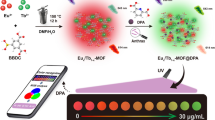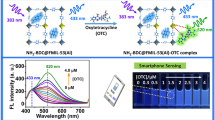Abstract
Terbium(III)-functionalized zirconium-based MOFs (Tb3+@UIO-67) were synthesized by doping Tb3+ into UIO-67 using a post-synthetic modification. The Tb3+@UIO-67 (solid or aqueous dispersion) shows only blue fluorescence (emission peaks at 420 nm) under an ultraviolet lamp (254 nm). Upon addition of 2,6-pyridinedicarboxylic acid (DPA; an anthrax biomarker), the color of the Tb3+@UIO-67 aqueous dispersion under an ultraviolet lamp changes from blue to green. This is mainly because DPA has a good sensitization effect on Tb3+. DPA can be determined by measurement of the ratio of the fluorescence intensities at 544 nm and 420 nm (excitation at 278 nm). The method allows DPA to be detected in the 0.3 to 6 μM concentration range, with a detection limit of 36 nM.

Schematic representation of a ratiometric fluorescent probe synthesized by doping terbium ions into a zirconium-based MOF (UIO-67) for determination of an anthrax biomarker.








Similar content being viewed by others
References
Kim J, Kim HS, Lee N, Kim T, Kim H, Yu T, Song IC, Moon WK, Hyeon T (2008) Multifunctional uniform nanoparticles composed of a magnetite Nanocrystal Core and a Mesoporous silica Shell for magnetic resonance and fluorescence imaging and for drug delivery. Angew Chem Int Ed 47(44):8438–8441
Oh WK, Jeong YS, Song J, Jang J (2011) Fluorescent europium-modified polymer nanoparticles for rapid and sensitive Anthrax sensors. Biosens Bioelectron 29(1):172–177
Rong MC, Deng XZ, Chi ST, Huang LZ, Zhou YB, Shen YN, Chen X (2018) Ratiometric fluorometric determination of the anthrax biomarker 2,6-dipicolinic acid by using europium(III)-doped carbon dots in a test stripe. Microchim Acta 185(3):201
Slieman TA, Nicholson WL (2001) Role of dipicolinic acid in survival of Bacillus subtilis spores exposed to artificial and solar UV radiation. Appl Environ Microbiol 67(3):1274–1279
Bell SEJ, Mackle JN, Sirimuthu NMS (2005) Quantitative surface-enhanced Raman spectroscopy of dipicolinic acid - towards rapid anthrax endospore detection. Analyst 130(4):545–549
Voorhees KJ, Hadfield TL, Cody RB (2000) Electron monochromator mass spectrometry for the analysis of whole bacteria and bacterial spores. Anal Chem 72(11):2428–2432
Tan CL, Wang QM, Zhang CC (2011) Optical and electrochemical responses of an anthrax biomarker based on single-walled carbon nanotubes covalently loaded with terbium complexes. Chem Commun 47(46):12521–12523
Kim J, Yoon MY (2010) Recent advances in rapid and ultrasensitive biosensors for infectious agents: lesson from Bacillus anthracis diagnostic sensors. Analyst 135(6):1182–1190
Donmez M, Yilmaz MD, Kilbas B (2017) Fluorescent detection of dipicolinic acid as a biomarker of bacterial spores using lanthanide-chelated gold nanoparticles. J Hazard Mater 324:593–598
Luo YQ, Zhang L, Zhang LY, Yu BH, Wang YJ, Zhang WB (2019) Multiporous terbium Phosphonate coordination polymer microspheres as fluorescent probes for trace Anthrax biomarker detection. ACS Appl Mater Inter 11(17):15998–16005
Bhardwaj N, Bhardwaj S, Mehta J, Kim KH, Deep A (2016) Highly sensitive detection of dipicolinic acid with a water-dispersible terbium-metal organic framework. Biosens Bioelectron 86:799–804
Cai KY, Zeng ML, Liu FF, Liu N, Huang ZZ, Song YH, Wang L (2017) BSA-AuNPs@Tb-AMP metal-organic frameworks for ratiometric fluorescence detection of DPA and Hg2+. Luminescence 32(7):1277–1282
Qu SM, Song NZ, Xu GX, Jia Q (2019) A ratiometric fluorescent probe for sensitive detection of anthrax biomarker based on terbium-covalent organic polymer systems. Sensors Actuators B Chem 290:9–14
Zhang YH, Li B, Ma HP, Zhang LM, Zheng YX (2016) Rapid and facile ratiometric detection of an anthrax biomarker by regulating energy transfer process in bio-metal-organic framework. Biosens Bioelectron 85:287–293
Zhang YH, Li B, Ma HP, Zhang LM, Jiang H, Song H, Zhang LG, Luo YS (2016) A nanoscaled lanthanide metal-organic framework as a colorimetric fluorescence sensor for dipicolinic acid based on modulating energy transfer. J Mater Chem C 4(30):7294–7301
Zhang DN, Zhou Y, Cuan J, Gan N (2018) A lanthanide functionalized MOF hybrid for ratiometric luminescence detection of an anthrax biomarker. Crystengcomm 20(9):1264–1270
Weng H, Yan B (2017) A sliver ion fabricated lanthanide complex as a luminescent sensor for aspartic acid. Sensors Actuators B Chem 253:1006–1011
Ma J, Yan B (2018) Multi-component hybrid soft ionogels for photoluminescence tuning and sensing organic solvent vapors. J Colloid Interface Sci 513:133–140
Zhang Y, Yan B (2019) A ratiometric fluorescent sensor with dual response of Fe3+/Cu2+ based on europium post-modified sulfone-metal-organic frameworks and its logical application. Talanta 197:291–298
He YB, Zhou W, Qian GD, Chen BL (2014) Methane storage in metal–organic frameworks. Chem Soc Rev 43(16):5657–5678
Qiu SL, Xue M, Zhu GS (2014) Metal-organic framework membranes: from synthesis to separation application. Chem Soc Rev 43(16):6116–6140
Huang YB, Liang J, Wang XS, Gao R (2017) Multifunctional metal-organic framework catalysts: synergistic catalysis and tandem reactions. Chem Soc Rev 46(1):126–157
Cai W, Chu CC, Liu G, Wang YXJ (2015) Metal-organic framework-based Nanomedicine platforms for drug delivery and molecular imaging. Small 11(37):4806–4822
Xu XY, Yan B (2016) Eu(III) functionalized Zr-based metal-organic framework as excellent fluorescent probe for Cd2+ detection in aqueous environment. Sensors Actuators B Chem 222:347–353
Li LN, Shen SS, Ai WP, Song SY, Bai Y, Liu HW (2018) Facilely synthesized Eu3+ post-functionalized UiO-66-type metal-organic framework for rapid and highly selective detection of Fe3+ in aqueous solution. Sensors Actuators B Chem 267:542–548
Zhang XX, Zhang WJ, Li CL, Qin XX, Zhu CY (2019) Eu3+-Postdoped UIO-66-type metal-organic framework as a luminescent sensor for Hg2+ detection in aqueous media. Inorg Chem 58(6):3910–3915
Zheng HY, Lian X, Qin SJ, Yan B (2018) Novel "turn-on" fluorescent probe for highly selectively sensing fluoride in aqueous solution based on Tb3+-functionalized metal-organic frameworks. ACS Omega 3(10):12513–12519
Qin SJ, Yan B (2018) A facile indicator box based on Eu3+ functionalized MOF hybrid for the determination of 1-naphthol, a biomarker for carbaryl in urine. Sensors Actuators B Chem 259:125–132
Sun NN, Yan B (2018) Fluorescence detection of urinary N-methylformamide for biomonitoring of human occupational exposure to N,N-dimethylformamide by Eu(III) functionalized MOFs. Sensors Actuators B Chem 261:153–160
Li ZQ, Wang GN, Wang YG, Li HR (2018) Reversible phase transition of robust luminescent hybrid hydrogels. Angew Chem Int Ed 130(8):2216–2220
Bugaev AL, Guda AA, Lomachenko KA, Kamyshova EG, Soldatov MA, Kaur G, Oien-Odegaard S, Braglia L, Lazzarini A, Manzoli M, Bordiga S, Olsbye U, Lillerud KP, Soldatov AV, Lamberti C (2018) Operando study of palladium nanoparticles inside UiO-67 MOF for catalytic hydrogenation of hydrocarbons. Faraday Discuss 208:287–306
Das A, Anbu N, Mostakim SK, Dhakshinamoorthy A, Biswas S (2019) Highly active urea-functionalized Zr(IV)-UiO-67 metal-organic framework as hydrogen bonding heterogeneous catalyst for Friedel-crafts alkylation. Inorg Chem 58(8):5163–5172
Maksimchuk NV, Lee JS, Solovyeva MV, Cho KH, Shmakov AN, Chesalov YA, Chang JS, Kholdeeva OA (2019) Protons make possible Heterolytic activation of hydrogen peroxide over Zr-based metal-organic frameworks. ACS Catal 9(11):9699–9704
Zhong GH, Liu DX, Zhang JY (2018) Incorporation of functional groups expands the applications of UiO-67 for adsorption, catalysis and Thiols detection. Chemistryselect 3(25):7066–7080
Zhou Y, Yan B (2015) Lanthanides post-functionalized nanocrystalline metal-organic frameworks for tunable white-light emission and orthogonal multi-readout thermometry. Nanoscale 7(9):4063–4069
Lian X, Yan B (2018) Trace detection of Organophosphorus chemical warfare agents in wastewater and plants by luminescent UIO-67(Hf) and evaluating the bioaccumulation of Organophosphorus chemical warfare agents. ACS Appl Mater Inter 10(17):14869–14876
Ma J, Yan B (2019) Multi-component luminescence responsive Eu3+/Tb3+ hybrids based with metal-organic frameworks and zeolites a. Spectrochim Acta A 220:117107
Zhang DW, Zhao J, Liu QL, Xia ZG (2019) Synthesis and luminescence properties of CsPbX3@Uio-67 composites toward stable photoluminescence convertors. Inorg Chem 58(2):1690–1696
Xu QQ, Li ZQ, Li HR (2016) Water-soluble luminescent hybrid composites consisting of Oligosilsesquioxanes and lanthanide complexes and their sensing ability for Cu2+. Chem Eur J 22(9):3037–3043
Ding LG, Yao BJ, Jiang WL, Li JT, Fu QJ, Li YA, Liu ZH, Ma JP, Dong YB (2017) Bifunctional lmidazolium-based ionic liquid decorated UiO-67 type MOF for selective CO2 adsorption and catalytic property for CO2 Cycloaddition with epoxides. Inorg Chem 56(4):2337–2344
Maza WA, Morris AJ (2014) Photophysical characterization of a ruthenium(II) Tris(2,2′ bipyridine)-doped zirconium UiO-67 metal organic framework. J Phys Chem C 118(17):8803–8817
Li PJ, Ang AN, Feng HT, Li SFY (2017) Rapid detection of an anthrax biomarker based on the recovered fluorescence of carbon dot-cu(II) systems. J Mater Chem C 5(28):6962–6972
Zhou Z, Gu JP, Chen YZ, Zhang XX, Wu HX, Qiao XG (2019) Europium functionalized silicon quantum dots nanomaterials for ratiometric fluorescence detection of Bacillus anthrax biomarker. Spectrochim Acta A 212:88–93
Li YX, Li XQ, Wang D, Shen CC, Yang MH (2018) Hydroxyapatite nanoparticle based fluorometric turn-on determination of dipicolinic acid, a biomarker of bacterial spores. Microchim Acta 185(9):435
Chen H, Xie YJ, Kirillov AM, Liu LL, Yu MH, Liu WS, Tang Y (2015) A ratiometric fluorescent nanoprobe based on terbium functionalized carbon dots for highly sensitive detection of an anthrax biomarker. Chem Commun 51(24):5036–5039
Acknowledgements
This work was supported by Department of Education of Hebei Province (No. ZD2017214).
Author information
Authors and Affiliations
Corresponding authors
Ethics declarations
Conflict of interest
There are no conflicts to declare
Additional information
Publisher’s note
Springer Nature remains neutral with regard to jurisdictional claims in published maps and institutional affiliations.
Electronic supplementary material
ESM 1
(DOCX 1.48 mb)
Rights and permissions
About this article
Cite this article
Zhang, X., Zhang, W., Li, G. et al. A ratiometric fluorescent probe for determination of the anthrax biomarker 2,6-pyridinedicarboxylic acid based on a terbium(III)− functionalized UIO-67 metal-organic framework. Microchim Acta 187, 122 (2020). https://doi.org/10.1007/s00604-020-4113-2
Received:
Accepted:
Published:
DOI: https://doi.org/10.1007/s00604-020-4113-2




